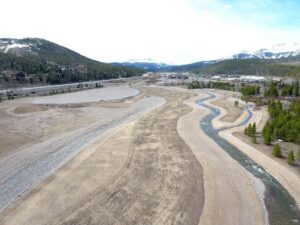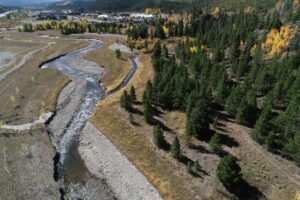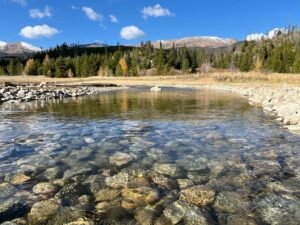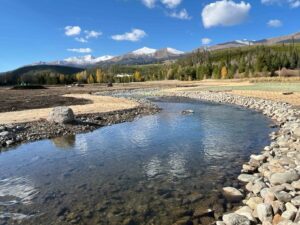Runoff in Summit County, Colorado was above average in 2019 producing flows that exceeded a 5-year event. Unfortunately this flow event was enough to result in widespread failure of a stream and valley restoration project completed by others for the Town of Breckenridge just two years prior. ERC was retained as the technical expert to complete a forensic evaluation of the design and construction process to determine the cause(s) of failure and support the Town in litigation after the defective work.
The project that had failed included a PVC linear below a linear, rock armored channel through a relatively wide alluvial mountain valley. A liner was a necessary part of the project as it mitigated historic mining activities that altered topography and substrate to a point where water flowed subsurface through the project area. Project review showed that the river design, which was intended to create an armored threshold channel that locked the river in place up to a 100-year event, was dramatically inadequate resulting in the wholesale mobilization of channel bed and banks and loss of the channel lining at a flow less than half of the intended design flow rate. Errors in channel sizing, hydraulic modeling and stability calculations were all found to contribute to project failure. When investigating ways to mitigate the failed project it was determined that large angular riprap exceeding three feet in diameter would be required to stabilize the originally designed threshold channel with its alignment and profile. Costs for such are repair were prohibitive while the aesthetics and ecological function of a riprap armored channel were deemed unacceptable.
ERC determined that using a natural restoration approach as opposed to the original, structural threshold channel design allowed the stream and valley to be restored to a condition that optimized the riverine and riparian environment at a cost that was approximately 1/3 of the cost of the linear, riprap armored channel alternative. ERC’s design created a meandering riffle/pool system based on the fundamentals of fluvial geomorphology that did not required import of any rock material. The function of the original PVC liner was replaced by a natural lower permeability soil layer that was manufactured by materials generated during the excavation of the failed channel. Rather than large riprap, the natural approach utilizes frequently spaced riffle features and connection to the low overbanks to dissipate energy during high flow events.
Original Threshold Channel in May 2017
Rock Armored Channel was Intended to Remain Stable for 100-Year Flood

Original Threshold Channel After 5+Year Event in 2019
Channel Bed and Banks Mobilized and Buried PVC Liner was Destroyed

Natural Channel After 2022 Mitigation Project
Instream Riffles and Pools Provide Habitat while Low Overbanks Allow Flood Flows to Overtop
Channel and Dissipate Energy as Occurs in a Natural River System

Natural Channel After 2022 Mitigation Project
Meandering Stream is Based on Principles of Fluvial Geomorphology Required No Rock Import or PVC
Lining and Cost ~ 1/3 of Hard Armored Mitigation
